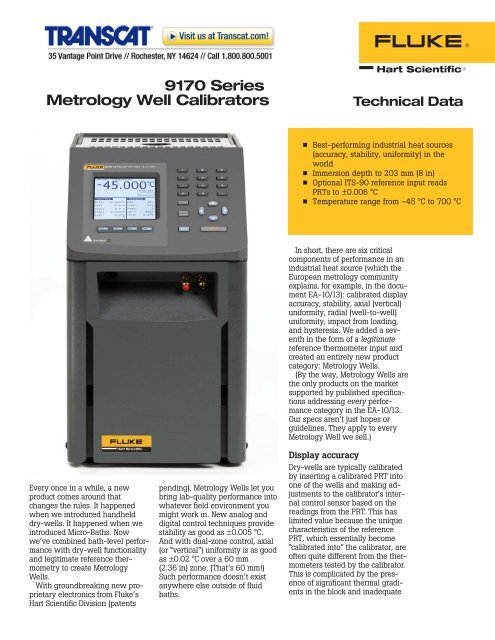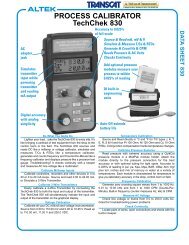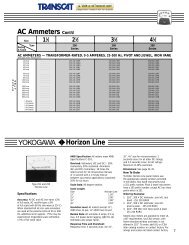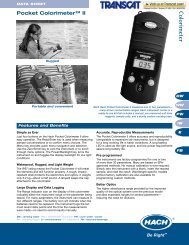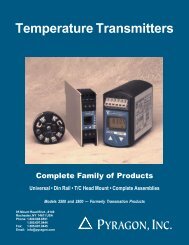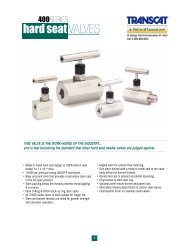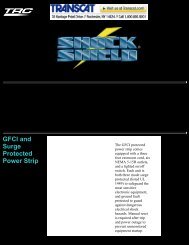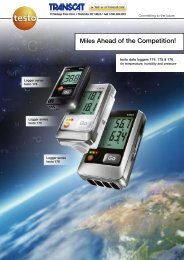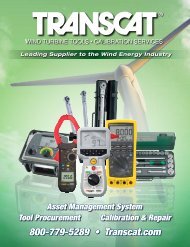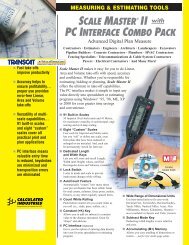Manufacturer PDF - Transcat
Manufacturer PDF - Transcat
Manufacturer PDF - Transcat
You also want an ePaper? Increase the reach of your titles
YUMPU automatically turns print PDFs into web optimized ePapers that Google loves.
9170 Series<br />
Metrology Well Calibrators<br />
Technical Data<br />
■ Best-performing industrial heat sources<br />
(accuracy, stability, uniformity) in the<br />
world<br />
■ Immersion depth to 203 mm (8 in)<br />
■ Optional ITS-90 reference input reads<br />
PRTs to ±0.006 °C<br />
■ Temperature range from –45 °C to 700 °C<br />
Everyonceinawhile,anew<br />
product comes around that<br />
changes the rules. It happened<br />
when we introduced handheld<br />
dry-wells. It happened when we<br />
introduced Micro-Baths. Now<br />
we’ve combined bath-level performance<br />
with dry-well functionality<br />
and legitimate reference thermometrytocreateMetrology<br />
Wells.<br />
With groundbreaking new proprietary<br />
electronics from Fluke’s<br />
Hart Scientific Division (patents<br />
pending), Metrology Wells let you<br />
bring lab-quality performance into<br />
whatever field environment you<br />
might work in. New analog and<br />
digital control techniques provide<br />
stability as good as ±0.005 °C.<br />
And with dual-zone control, axial<br />
(or “vertical”) uniformity is as good<br />
as±0.02°Covera60mm<br />
(2.36 in) zone. (That’s 60 mm!)<br />
Such performance doesn’t exist<br />
anywhere else outside of fluid<br />
baths.<br />
In short, there are six critical<br />
components of performance in an<br />
industrial heat source (which the<br />
European metrology community<br />
explains, for example, in the document<br />
EA-10/13): calibrated display<br />
accuracy, stability, axial (vertical)<br />
uniformity, radial (well-to-well)<br />
uniformity, impact from loading,<br />
andhysteresis.Weaddedaseventh<br />
in the form of a legitimate<br />
reference thermometer input and<br />
created an entirely new product<br />
category: Metrology Wells.<br />
(By the way, Metrology Wells are<br />
theonlyproductsonthemarket<br />
supported by published specifications<br />
addressing every performance<br />
category in the EA-10/13.<br />
Our specs aren’t just hopes or<br />
guidelines.Theyapplytoevery<br />
Metrology Well we sell.)<br />
Display accuracy<br />
Dry-wells are typically calibrated<br />
by inserting a calibrated PRT into<br />
one of the wells and making adjustments<br />
to the calibrator’s internal<br />
control sensor based on the<br />
readings from the PRT. This has<br />
limited value because the unique<br />
characteristics of the reference<br />
PRT, which essentially become<br />
“calibrated into” the calibrator, are<br />
often quite different from the thermometers<br />
tested by the calibrator.<br />
This is complicated by the presence<br />
of significant thermal gradients<br />
in the block and inadequate
Built-In Reference Thermometry!<br />
Fluke’s Hart Scientific Division has been<br />
making the world’s best thermometer<br />
readout devices for quite some time. Our<br />
Super-Thermometer, Black Stack, and<br />
Tweener thermometers are well-known<br />
everywhere. Now we’re making our proprietary<br />
Tweener measurement circuitry<br />
available directly in a heat source — our<br />
new Metrology Wells.<br />
This optionally built-in input accepts<br />
100-, 25-, and 10-ohm PRTs. It reads<br />
thermometer probes accurately from<br />
±0.006°Cat0°Cto±0.027°Cat661°C,<br />
not including errors from the probe. It is<br />
compatible with every PRT sold by Hart<br />
and connects to Metrology Wells via a<br />
5-pin DIN connector.<br />
sensor immersion into blocks that<br />
are simply too short.<br />
Metrology Wells are different.<br />
Temperature gradients, loading<br />
effects, and hysteresis have been<br />
minimized to make the calibration<br />
of the display much more meaningful.<br />
We use only traceable, accredited<br />
PRTs to calibrate<br />
Metrology Wells and our proprietary<br />
electronics consistently demonstrate<br />
repeatable accuracy more<br />
than ten times better than our<br />
specs, which range from ±0.1 °C at<br />
themostcommonlyused<br />
temperatures to ±0.25 °C at<br />
661 °C.<br />
For even better accuracy, Metrology<br />
Wells may be ordered with<br />
built-in electronics for reading<br />
external PRTs with ITS-90 characterizations.<br />
(See sidebar, Built in<br />
Reference Thermometry, above.)<br />
Stability<br />
Heat sources from Hart have long<br />
been known as the most stable<br />
heat sources in the world. It only<br />
gets better with Metrology Wells.<br />
Both low-temperature units (Models<br />
9170 and 9171) are stable to<br />
±0.005 °C over their full range.<br />
Even the 700 °C unit (Model 9173)<br />
achieves stability of ±0.03 °C.<br />
Better stability can only be found<br />
in fluid baths and primary<br />
Two things dramatically differentiate<br />
the Tweener circuit from the measurement<br />
electronics built into many<br />
dry-wells. First, it accepts unique<br />
ITS-90 characterization coefficients<br />
from reference thermometers, which<br />
allow you to take full advantage of the<br />
accuracies of those thermometers. Second,<br />
it comes with a traceable, accredited<br />
calibration, providing you full<br />
confidence in the integrity of its<br />
measurements.<br />
Nothing beats a Hart Metrology Well<br />
for industrial thermal performance.<br />
And nothing beats a Tweener measurement<br />
for built-in reference<br />
thermometry.<br />
fixed-point devices. The<br />
“off-the-shelf controllers” used by<br />
most dry-well manufacturers simply<br />
can’t provide this level of<br />
performance.<br />
Axial uniformity<br />
The EA-10/13 document suggests<br />
that dry-wells should include a<br />
zone of maximum temperature homogeneity,<br />
which extends for 40<br />
mm (1.54 in), usually at the bottom<br />
of a well. Metrology Wells, however,<br />
combine our unique electronics<br />
with dual-zone control and<br />
more well depth than is found in<br />
dry-wells to provide homogeneous<br />
zones over 60 mm (2.36 in). Vertical<br />
gradients in these zones range<br />
from±0.02°Cat0°Cto±0.4°Cat<br />
700 °C.<br />
What’s more, Metrology Wells<br />
actually have these specifications<br />
published for each unit, and we<br />
stand by them. We even offer a<br />
specially-constructed PRT for testing<br />
axial uniformity (models 5662<br />
and 5663).<br />
Radial uniformity<br />
Radial uniformity is the difference<br />
in temperature between one well<br />
and another well. For poorly designed<br />
heat sources, or when<br />
large-diameter probes are used,<br />
these differences can be very<br />
large. For Metrology Wells, we define<br />
our specification as the largest<br />
temperature difference between<br />
the vertically homogeneous zones<br />
of any two wells that are each 6.4<br />
mm (0.25 in) in diameter or<br />
smaller. The cold units (9170 and<br />
9171) provide radial uniformity of<br />
±0.01°Candthehotunits(9172<br />
and 9173) range from ±0.01 °C to<br />
±0.04°C(at700°C).<br />
Loading<br />
Loading is defined as the change<br />
in temperature sensed by a reference<br />
thermometer inserted into<br />
the bottom of a well after the rest<br />
of the wells are filled with thermometers,<br />
too.<br />
For Metrology Wells, loading effects<br />
are minimized for the same<br />
reasons that axial gradients are<br />
minimized. We use deeper wells<br />
than found in dry-wells. And we<br />
utilize proprietary dual-zone controls.<br />
Loading effects are as minimalas±0.005°Cinthecoldunits.<br />
Hysteresis<br />
Thermal hysteresis exists far more<br />
in internal control sensors than in<br />
good-quality reference PRTs. It is<br />
evidenced by the difference in two<br />
external measurements of the<br />
same set-point temperature when<br />
that temperature is approached<br />
from two different directions (hotter<br />
or colder) and is usually largest<br />
at the midpoint of a heat source’s<br />
temperature range. It exists because<br />
control sensors are typically<br />
designed for ruggedness and do<br />
not have the “strain free” design<br />
characteristics of SPRTs, or even<br />
most PRTs. For Metrology Wells,<br />
hysteresis effects range from<br />
±0.025 °C to ±0.07 °C.<br />
Immersion depth<br />
Immersion depth matters. Not only<br />
does it help minimize axial gradient<br />
and loading effects, it helps<br />
address the unique immersion<br />
characteristics of each thermometer<br />
tested in the heat source.<br />
Those characteristics include the<br />
location and size of the actual sensor<br />
within the probe, the width<br />
2 Fluke Corporation, Hart Scientific Division Metrology Well Calibrators
1/4 in<br />
3/16 in<br />
3/8 in<br />
1/4 in<br />
1/8 in<br />
1/4 in<br />
Insert “A”<br />
3/8 in<br />
1/4 in<br />
3/16 in<br />
3/8 in<br />
3/16 in<br />
1/4 in<br />
Insert “B”<br />
1/4 in 1/4 in<br />
Metrology Well displays offer all the information needed to perform calibrations — control and<br />
reference probe temperatures, heating and cooling status, set-point temperature, stability criteria,<br />
and more.<br />
1/4 in<br />
1/4 in<br />
1/4 in<br />
1/4 in<br />
and thermal mass of the probe,<br />
and the lead wires used to connectthesensortotheoutside<br />
world. Metrology Wells feature<br />
well depths of 203 mm (8 in) in<br />
the Models 9171, 9172, and 9173.<br />
The Model 9170 is 160 mm (6.3 in)<br />
deep to facilitate temperature of<br />
–45 °C.<br />
Other great features<br />
A large LCD display, numeric keypad,<br />
and on-screen menus make<br />
use of Metrology Wells simple and<br />
intuitive. The display shows the<br />
block temperature, built-in reference<br />
thermometer temperature,<br />
cutout temperature, stability criteria,<br />
and ramp rate. The user interface<br />
can be configured to display<br />
in English, French, or Chinese<br />
(French and Chinese to be implemented<br />
in 2006).<br />
All four models come with an<br />
RS-232 serial interface and the<br />
Model 9930, Interface-it software.<br />
All are also compatible with Model<br />
9938 MET/TEMP II software for<br />
completely automated calibrations<br />
of RTDs, thermocouples, and<br />
thermistors (Metrology Wells with<br />
built-in reference input options<br />
will be compatible with<br />
MET/TEMP II in early 2006).<br />
Even without a PC, Metrology<br />
Wells have four different preprogrammed<br />
calibration tasks that allow<br />
up to eight temperature set<br />
points with “ramp and soak” times<br />
between each. There is an automated<br />
“switch test” protocol that<br />
zeros in on the “dead-band” for<br />
thermal switches. And a dedicated<br />
°C/°F button allows for easy<br />
switching of temperature units.<br />
Any of six standard inserts may<br />
be ordered with each unit, accommodating<br />
a variety of metric- and<br />
imperial-sized probe diameters.<br />
(See inset at right.) And Metrology<br />
Wells are small enough and light<br />
enough to go anywhere.<br />
9170<br />
The Model 9170 achieves the lowest<br />
temperatures of the series,<br />
reaching –45 °C in normal room<br />
conditions. The 9170 is stable to<br />
±0.005 °C over its full temperature<br />
range (up to 140 °C) and has 160<br />
mm (6.3 in) of immersion depth.<br />
With axial uniformity of ±0.02 °C<br />
and radial uniformity of ±0.01 °C,<br />
this model delivers exceptional<br />
uncertainty budgets and is perfect<br />
Insert “C”<br />
4 mm 3 mm<br />
6 mm 6 mm<br />
3 mm 4 mm<br />
Insert “D”<br />
0.25 in<br />
3 mm<br />
10 mm<br />
8 mm<br />
4 mm<br />
6 mm<br />
Insert “E”<br />
3 mm<br />
4 mm<br />
6 mm<br />
0.25 in<br />
4 mm 3 mm<br />
Insert “F”<br />
Fluke Corporation, Hart Scientific Division Metrology Well Calibrators 3
The Metrology Well family consist of four models (Model 9170, 9171, 9172, and 9173) which, combined, cover a<br />
temperature range of -45 °C to 700 °C.<br />
for a variety of pharmaceutical and<br />
other applications.<br />
9171<br />
If you need more depth, the Model<br />
9171 provides 203 mm (8 in) of<br />
immersion over temperatures from<br />
–30 °C all the way to 155 °C with<br />
full-range stability of ±0.005 °C.<br />
Just like the 9170, this dry-well<br />
has exceptional axial and radial<br />
uniformity. The display of the 9171<br />
is calibrated to an accuracy of<br />
±0.1 °C over its full range.<br />
9172<br />
The Model 9172 provides temperatures<br />
from 35 °C to 425 °C with a<br />
calibrated display accurate to<br />
±0.2 °C at 425 °C. In addition to<br />
exceptional accuracy, the 9172 is<br />
stable from ±0.005 °C to ±0.01 °C,<br />
depending on temperature. With<br />
203 mm (8 in) of immersion, the<br />
9172 significantly reduces stem<br />
conduction errors at hightemperatures.<br />
9173<br />
For work between 50 °C and<br />
700 °C, the Model 9173 provides<br />
unmatched performance. The 9173<br />
hasadisplayaccuracyof±0.25°C<br />
at700°Candanimmersiondepth<br />
of 203 mm (8 in). Stability and<br />
uniformity performance of this unit<br />
are enough to dramatically reduce<br />
uncertainty budgets for calibrations<br />
of thermometers at high<br />
temperatures.<br />
Of course, there’s still a place in<br />
the world for dry-wells or “dry<br />
block” calibrators. In fact, Hart<br />
makes and will continue to make<br />
some of the best performing, portable,<br />
fast dry-wells in the world.<br />
There’s still nothing better for a<br />
quick test of industrial temperature<br />
sensor performance.<br />
Wejustcan’tresisttheurge,<br />
though, to keep coming up with<br />
breakthrough product designs that<br />
can dramatically impact the ways<br />
people work and the results they<br />
see. For the absolute best performance<br />
in a portable temperature<br />
source, Metrology Wells raise the<br />
standard to an entirely new level.<br />
Fluke Corporation, Hart Scientific Division Metrology Well Calibrators 4
Specifications<br />
Range (at 23 °C ambient) –45 °C to 140 °C<br />
(–49 °F to 284 °F)<br />
9170 9171 9172 9173<br />
–30 °C to 155 °C<br />
(–22 °F to 311 °F)<br />
35 °C to 425 °C<br />
(95 °F to 797 °F)<br />
Display Accuracy ±0.1 °C full range ±0.1 °C at 100 °C<br />
±0.15 °C at 225 °C<br />
±0.2 °C at 425 °C<br />
Stability ±0.005 °C full range ±0.005 °C to 100 °C<br />
±0.008 °C to 225 °C<br />
±0.01 °C to 425 °C<br />
Axial Uniformity (60 mm) ±0.1 °C at –45 °C<br />
±0.04 °C at –35 °C<br />
±0.02 °C at 0 °C<br />
±0.07 °C at 140 °C<br />
±0.025 °C at –30 °C<br />
±0.02 °C at 0 °C<br />
±0.07 °C at 155 °C<br />
±0.05 °C at 100 °C<br />
±0.1 °C at 225 °C<br />
±0.2 °C at 425 °C<br />
Radial Uniformity ±0.01 °C full range ±0.01 °C at 100 °C<br />
±0.02 °C at 225 °C<br />
±0.025 °C at 425 °C<br />
Loading Effect (with a 6.35<br />
mm reference probe and three<br />
6.35 mm probes)<br />
±0.02 °C at –45 °C<br />
±0.005 °C at –35 °C<br />
±0.01 °C at 140 °C<br />
±0.005 °C at –30 °C<br />
±0.005 °C at 0 °C<br />
±0.01 °C at 155 °C<br />
50 °C to 700 °C †<br />
(122 °F to 1292 °F)<br />
±0.2 °C at 425 °C<br />
±0.25 °C at 660 °C<br />
±0.005 °C to 100 °C<br />
±0.01 °C to 425 °C<br />
±0.03 °C to 700 °C<br />
±0.1 °C at 100 °C<br />
±0.25 °C at 425 °C<br />
±0.4 °C at 700 °C<br />
±0.01 °C at 100 °C<br />
±0.025 °C at 425 °C<br />
±0.04 °C at 700 °C<br />
±0.01 °C full range ±0.02 °C at 425 °C<br />
±0.04 °C at 700 °C<br />
Hysteresis ±0.025 °C ±0.04 °C ±0.07 °C<br />
Well Depth 160 mm (6.3 in) 203 mm (8 in)<br />
Resolution 0.001 °C<br />
Display<br />
LCD, °C or °F, user-selectable<br />
Key Pad<br />
Ten key with decimal and +/- button. Function keys, menu key, and °C / °F key.<br />
Cooling Time 44 min: 23 °C to –45 °C<br />
19 min: 23 °C to –30 °C<br />
19 min: 140 °C to 23 °C<br />
Heating Time 32 min: 23 °C to 140 °C<br />
45 min: –45 °C to 140 °C<br />
Size (height x width x depth)<br />
30 min: 23 °C to –30 °C<br />
25 min: 155 °C to 23 °C<br />
44 min: 23 °C to 155 °C<br />
56 min: –30 °C to 155 °C<br />
220 min: 425 °C to 35 °C<br />
100 min: 425 °C to 100 °C<br />
235 min: 700 °C to 50 °C<br />
153 min: 700 °C to 100 °C<br />
27 min: 35 °C to 425 °C 46 min: 50 °C to 700 °C<br />
366 x 203 x 323 mm (14.4 x 8 x 12.7 in)<br />
Weight 15 kg (33 lb) 15 kg (33 lb) 13.2 kg (29 lb) 15 kg (33 lb)<br />
Power<br />
115 VAC (±10%), 6.3 A, or<br />
230 VAC (±10%), 3.15 A<br />
115 VAC (±10%), 10 A, or 230 VAC (±10%), 5 A<br />
Computer Interface<br />
Traceable Calibration (NIST)<br />
Data at –45 °C, 0 °C, 50 °C,<br />
100 °C, and 140 °C<br />
†<br />
Calibrated to 660 °C; reference thermometer recommended at higher temperatures.<br />
Specifications<br />
Temperature Range<br />
Resistance Range<br />
Characterizations<br />
Resistance Accuracy<br />
Temperature Accuracy (does<br />
not include probe uncertainty)<br />
Resistance Resolution<br />
Measurement Period<br />
Probe Connection<br />
Calibration<br />
10 PRTs:<br />
±0.013 °C at 0 °C<br />
±0.014 °C at 155 °C<br />
±0.019 °C at 425 °C<br />
±0.028 °C at 700 °C<br />
RS-232 Interface with 9930 Interface-it control software included<br />
Data at –30 °C, 0 °C, 50 °C,<br />
100 °C, and 155 °C<br />
Built-in Reference Input<br />
Data at 100 °C, 150 °C, 250 °C,<br />
350 °C, and 425 °C<br />
–200 °C to 962 °C (–328 °F to 1764 °F)<br />
0 Ω to 400 Ω, auto-ranging<br />
ITS-90 subranges 4, 6, 7, 8, 9, 10, and 11 Callendar-Van Dusen (CVD): R 0<br />
, α, β, δ<br />
0 Ω to 20 Ω: 0.0005 Ω<br />
20 Ω to 400 Ω: 25 ppm<br />
0 Ω to 20 Ω: 0.0001 Ω<br />
20 Ω to 400 Ω: 0.001 Ω<br />
1 second<br />
25 and 100 PRTs:<br />
±0.007 °C at –100 °C<br />
±0.006 °C at 0 °C<br />
±0.011 °C at 155 °C<br />
±0.013 °C at 225 °C<br />
±0.019 °C at 425 °C<br />
±0.027 °C at 661 °C<br />
4-wire with shield, 5-pin DIN connector<br />
NVLAP accredited (built-in reference input only), NIST-traceable calibration provided<br />
Data at 100 °C, 200 °C, 350 °C,<br />
500 °C, and 660 °C<br />
5 Fluke Corporation, Hart Scientific Division Metrology Well Calibrators
Ordering Information<br />
9170 Metrology Well<br />
9170-X Metrology Well, –45 °C to 140 °C,<br />
w/INSX<br />
9170-X-R Metrology Well, –45 °C to 140 °C,<br />
w/INSX, w/Built-In Reference<br />
X in the above model numbers to be replaced with A,<br />
B, C, D, E, or F as appropriate for the desired insert. See<br />
the illustration on page 3 and listing below.<br />
9170-INSA Insert “A”, 9170, Al, Misc Holes<br />
9170-INSB Insert “B”, 9170, Al, Comparison Holes<br />
9170-INSC Insert “C”, 9170, Al, 0.25-inch Holes<br />
9170-INSD Insert “D”, 9170, Al, Metric Comparison<br />
Holes<br />
9170-INSE Insert “E”, 9170, Al, Misc Metric Holes,<br />
w/0.25-inch Ref Hole<br />
9170-INSF Insert “F”, 9170, Al, Metric Comparison<br />
Holes, w/0.25-inch Ref Hole<br />
9170-INSZ Insert “Z”, 9170, Al, Blank<br />
9170-CASE Case, Carrying, 9170–3 Metrology Wells<br />
9170-DCAS Case, Transportation with Wheels,<br />
9170–3 Metrology Wells<br />
9172 Metrology Well<br />
9172-X Metrology Well, 35 °C to 425 °C, w/INSX<br />
9172-X-R Metrology Well, 35 °C to 425 °C,<br />
w/INSX, w/Built-In Reference<br />
X in the above model numbers to be replaced with A,<br />
B, C, D, E, or F as appropriate for the desired insert. See<br />
the illustration on page 3 and listing below.<br />
9172-INSA Insert “A”, 9172, Brass, Misc Holes<br />
9172-INSB Insert “B”, 9172, Brass, Comparison<br />
Holes<br />
9172-INSC Insert “C”, 9172, Brass, 0.25-inch Holes<br />
9172-INSD Insert “D”, 9172, Brass, Metric<br />
Comparison Holes<br />
9172-INSE Insert “E”, 9172, Brass, Misc Metric<br />
Holes, w/0.25-inch Ref Hole<br />
9172-INSF Insert “F”, 9172, Brass, Metric<br />
Comparison Holes, w/0.25-inch Ref<br />
Hole<br />
9172-INSZ Insert “Z”, 9172, Brass, Blank<br />
9170-CASE Case, Carrying, 9170–3 Metrology Wells<br />
9170-DCAS Case, Transportation with Wheels,<br />
9170–3 Metrology Wells<br />
9171 Metrology Well<br />
9171-X Metrology Well, –30 °C to 155 °C,<br />
w/INSX<br />
9171-X-R Metrology Well, –30 °C to 155 °C,<br />
w/INSX, w/Built-In Reference<br />
X in the above model numbers to be replaced with A,<br />
B, C, D, E, or F as appropriate for the desired insert. See<br />
the illustration on page 3 and listing below.<br />
9171-INSA Insert “A”, 9171, Al, Misc Holes<br />
9171-INSB Insert “B”, 9171, Al, Comparison Holes<br />
9171-INSC Insert “C”, 9171, Al, 0.25-inch Holes<br />
9171-INSD Insert “D”, 9171, Al, Comparison Metric<br />
Holes<br />
9171-INSE Insert “E”, 9171, Al, Misc Metric Holes,<br />
w/0.25-inch Ref Hole<br />
9171-INSF Insert “F”, 9171, Al, Metric Comparison<br />
Holes, w/0.25-inch Ref Hole<br />
9171-INSZ Insert “Z”, 9171, Al, Blank<br />
9170-CASE Case, Carrying, 9170–3 Metrology Wells<br />
9170-DCAS Case, Transportation with Wheels,<br />
9170–3 Metrology Wells<br />
9173 Metrology Well<br />
9173-X Metrology Well, 50 °C to 700 °C, w/INSX<br />
9173-X-R Metrology Well, 50 °C to 700 °C,<br />
w/INSX, w/Built-In Reference<br />
X in the above model numbers to be replaced with A,<br />
B, C, D, E, or F as appropriate for the desired insert. See<br />
the illustration on page 3 and listing below.<br />
9173-INSA Insert “A”, 9173, Al-Brnz, Misc Holes<br />
9173-INSB Insert “B”, 9173, Al-Brnz, Comparison<br />
Holes<br />
9173-INSC Insert “C”, 9173, Al-Brnz, 0.25-inch<br />
Holes<br />
9173-INSD Insert “D”, 9173, Al-Brnz, Comparison<br />
Metric Holes<br />
9173-INSE Insert “E”, 9173, Al-Brnz, Misc Metric<br />
Holes, w/0.25-inch Ref Hole<br />
9173-INSF Insert “F”, 9173, Al-Brnz, Metric<br />
Comparison Holes, w/0.25-inch Ref<br />
Hole<br />
9173-INSZ Insert “Z”, 9173, Al-Brnz, Blank<br />
9170-CASE Case, Carrying, 9170–3 Metrology Wells<br />
9170-DCAS Case, Transportation with Wheels,<br />
9170–3 Metrology Wells<br />
Fluke Corporation<br />
Hart Scientific Division<br />
799 E Utah Valley Drive<br />
American Fork, UT 84003<br />
Tel: 801.763.1600<br />
Fax: 801.763.1010<br />
E-mail: info@hartscientific.com<br />
For more information call:<br />
Europe/Africa/Middle East:<br />
Fluke Europe B.V.<br />
Hart Scientific Division<br />
P.O. Box 1186, 5602 BD<br />
Eindhoven, The Netherlands<br />
Tel: (31 40) 2 675 200<br />
Fax: (31 40) 2 675 222<br />
Canada<br />
Tel: 1-800-36-FLUKE or<br />
905.890.7600<br />
Fax: 905.890.6866<br />
Other countries<br />
Tel: 801.763.1600<br />
Fax: 801.763.1010<br />
Web access: www.hartscientific.com<br />
© 2005 Fluke Corporation, Hart Scientific Division.<br />
All rights reserved. Specifications subject to change<br />
without notice. Printed in U.S.A. 6/2005<br />
2458660 D-US-N Rev A<br />
6 Fluke Corporation, Hart Scientific Division Metrology Well Calibrators


